A Critical Analysis of the #MeToo Movement's Organizational Methods
VerifiedAdded on 2023/04/10
|6
|1573
|58
Essay
AI Summary
This essay examines the #MeToo movement, initiated by Tarana Burke in 2006 and popularized by Alyssa Milano, focusing on its organizational methods to prevent workplace harassment and sexual abuse. It discusses the movement's origins in response to allegations against Harvey Weinstein and other prominent figures, highlighting its rapid growth through social media and the unification of voices demanding change. The essay explores key organizational strategies, including data collection on abuse, union involvement, and the collaboration between #MeToo and #Time'sUp. It also addresses the challenges and backlashes faced by the movement, emphasizing the need for solutions that protect both accusers and the accused while promoting a more progressive and equitable society. The essay concludes by noting the movement's significant impact on raising awareness, advancing women's rights, and encouraging victims to come forward, while also acknowledging the importance of ensuring fairness and due process in accusations.
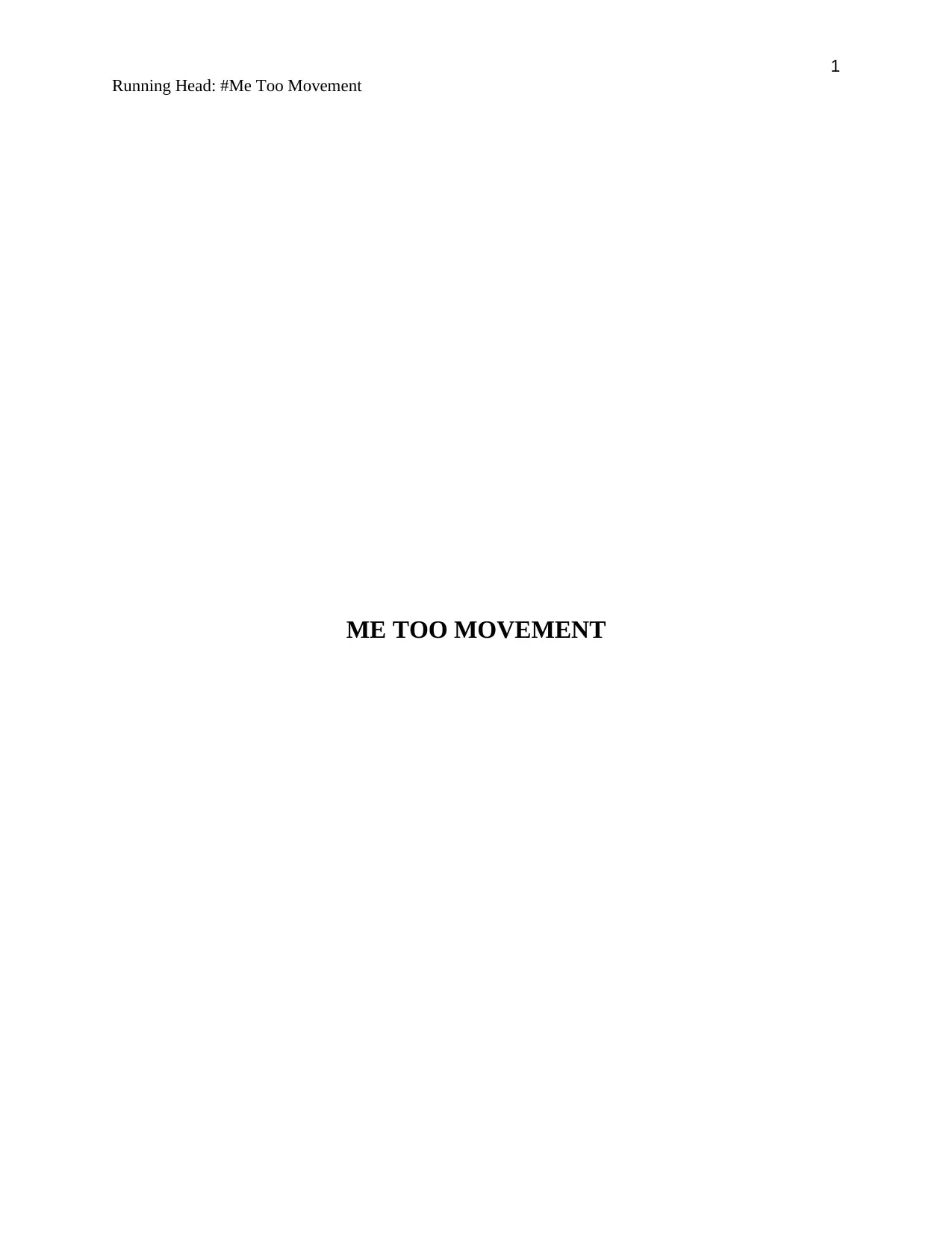
1
Running Head: #Me Too Movement
ME TOO MOVEMENT
Running Head: #Me Too Movement
ME TOO MOVEMENT
Paraphrase This Document
Need a fresh take? Get an instant paraphrase of this document with our AI Paraphraser
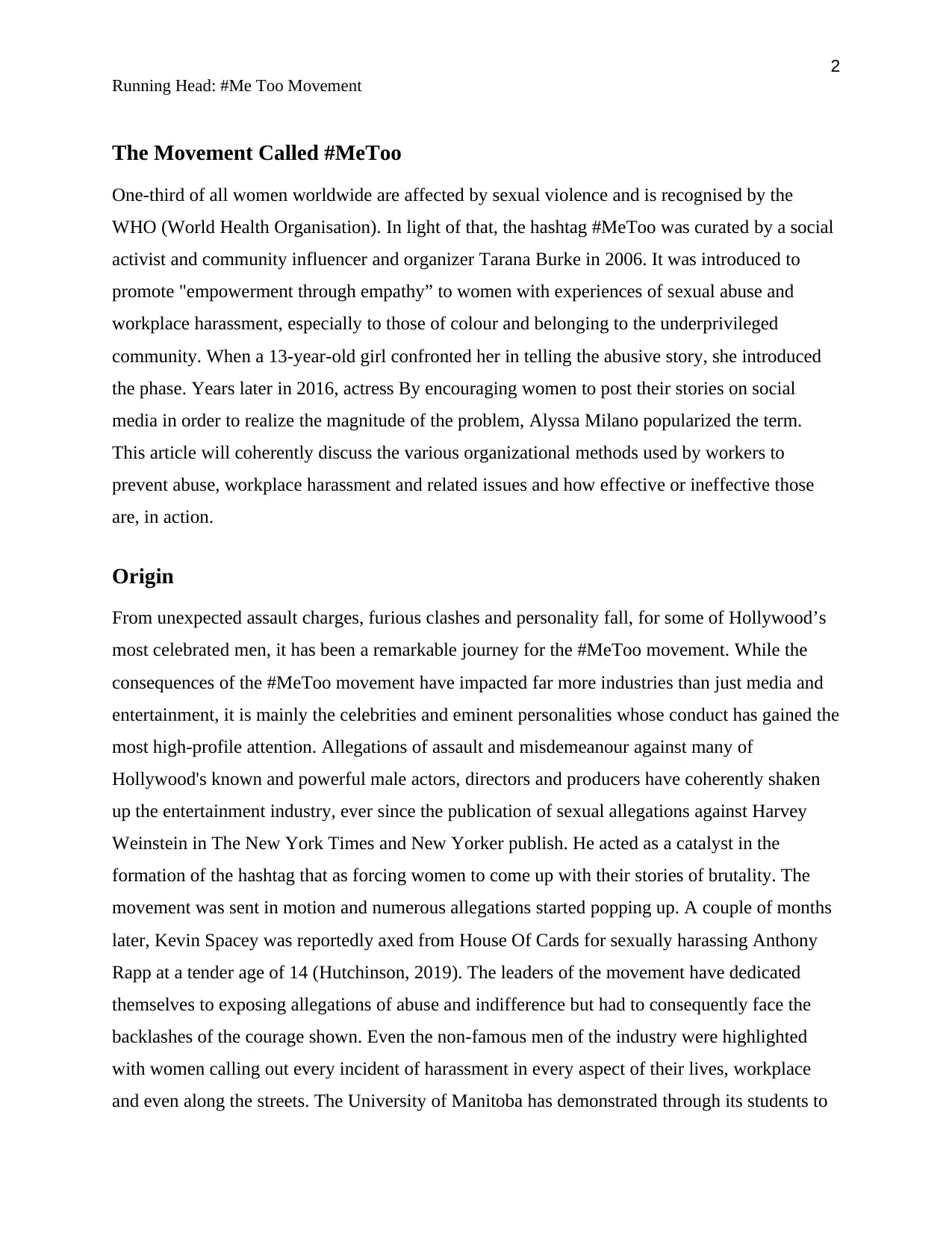
2
Running Head: #Me Too Movement
The Movement Called #MeToo
One-third of all women worldwide are affected by sexual violence and is recognised by the
WHO (World Health Organisation). In light of that, the hashtag #MeToo was curated by a social
activist and community influencer and organizer Tarana Burke in 2006. It was introduced to
promote "empowerment through empathy” to women with experiences of sexual abuse and
workplace harassment, especially to those of colour and belonging to the underprivileged
community. When a 13-year-old girl confronted her in telling the abusive story, she introduced
the phase. Years later in 2016, actress By encouraging women to post their stories on social
media in order to realize the magnitude of the problem, Alyssa Milano popularized the term.
This article will coherently discuss the various organizational methods used by workers to
prevent abuse, workplace harassment and related issues and how effective or ineffective those
are, in action.
Origin
From unexpected assault charges, furious clashes and personality fall, for some of Hollywood’s
most celebrated men, it has been a remarkable journey for the #MeToo movement. While the
consequences of the #MeToo movement have impacted far more industries than just media and
entertainment, it is mainly the celebrities and eminent personalities whose conduct has gained the
most high-profile attention. Allegations of assault and misdemeanour against many of
Hollywood's known and powerful male actors, directors and producers have coherently shaken
up the entertainment industry, ever since the publication of sexual allegations against Harvey
Weinstein in The New York Times and New Yorker publish. He acted as a catalyst in the
formation of the hashtag that as forcing women to come up with their stories of brutality. The
movement was sent in motion and numerous allegations started popping up. A couple of months
later, Kevin Spacey was reportedly axed from House Of Cards for sexually harassing Anthony
Rapp at a tender age of 14 (Hutchinson, 2019). The leaders of the movement have dedicated
themselves to exposing allegations of abuse and indifference but had to consequently face the
backlashes of the courage shown. Even the non-famous men of the industry were highlighted
with women calling out every incident of harassment in every aspect of their lives, workplace
and even along the streets. The University of Manitoba has demonstrated through its students to
Running Head: #Me Too Movement
The Movement Called #MeToo
One-third of all women worldwide are affected by sexual violence and is recognised by the
WHO (World Health Organisation). In light of that, the hashtag #MeToo was curated by a social
activist and community influencer and organizer Tarana Burke in 2006. It was introduced to
promote "empowerment through empathy” to women with experiences of sexual abuse and
workplace harassment, especially to those of colour and belonging to the underprivileged
community. When a 13-year-old girl confronted her in telling the abusive story, she introduced
the phase. Years later in 2016, actress By encouraging women to post their stories on social
media in order to realize the magnitude of the problem, Alyssa Milano popularized the term.
This article will coherently discuss the various organizational methods used by workers to
prevent abuse, workplace harassment and related issues and how effective or ineffective those
are, in action.
Origin
From unexpected assault charges, furious clashes and personality fall, for some of Hollywood’s
most celebrated men, it has been a remarkable journey for the #MeToo movement. While the
consequences of the #MeToo movement have impacted far more industries than just media and
entertainment, it is mainly the celebrities and eminent personalities whose conduct has gained the
most high-profile attention. Allegations of assault and misdemeanour against many of
Hollywood's known and powerful male actors, directors and producers have coherently shaken
up the entertainment industry, ever since the publication of sexual allegations against Harvey
Weinstein in The New York Times and New Yorker publish. He acted as a catalyst in the
formation of the hashtag that as forcing women to come up with their stories of brutality. The
movement was sent in motion and numerous allegations started popping up. A couple of months
later, Kevin Spacey was reportedly axed from House Of Cards for sexually harassing Anthony
Rapp at a tender age of 14 (Hutchinson, 2019). The leaders of the movement have dedicated
themselves to exposing allegations of abuse and indifference but had to consequently face the
backlashes of the courage shown. Even the non-famous men of the industry were highlighted
with women calling out every incident of harassment in every aspect of their lives, workplace
and even along the streets. The University of Manitoba has demonstrated through its students to
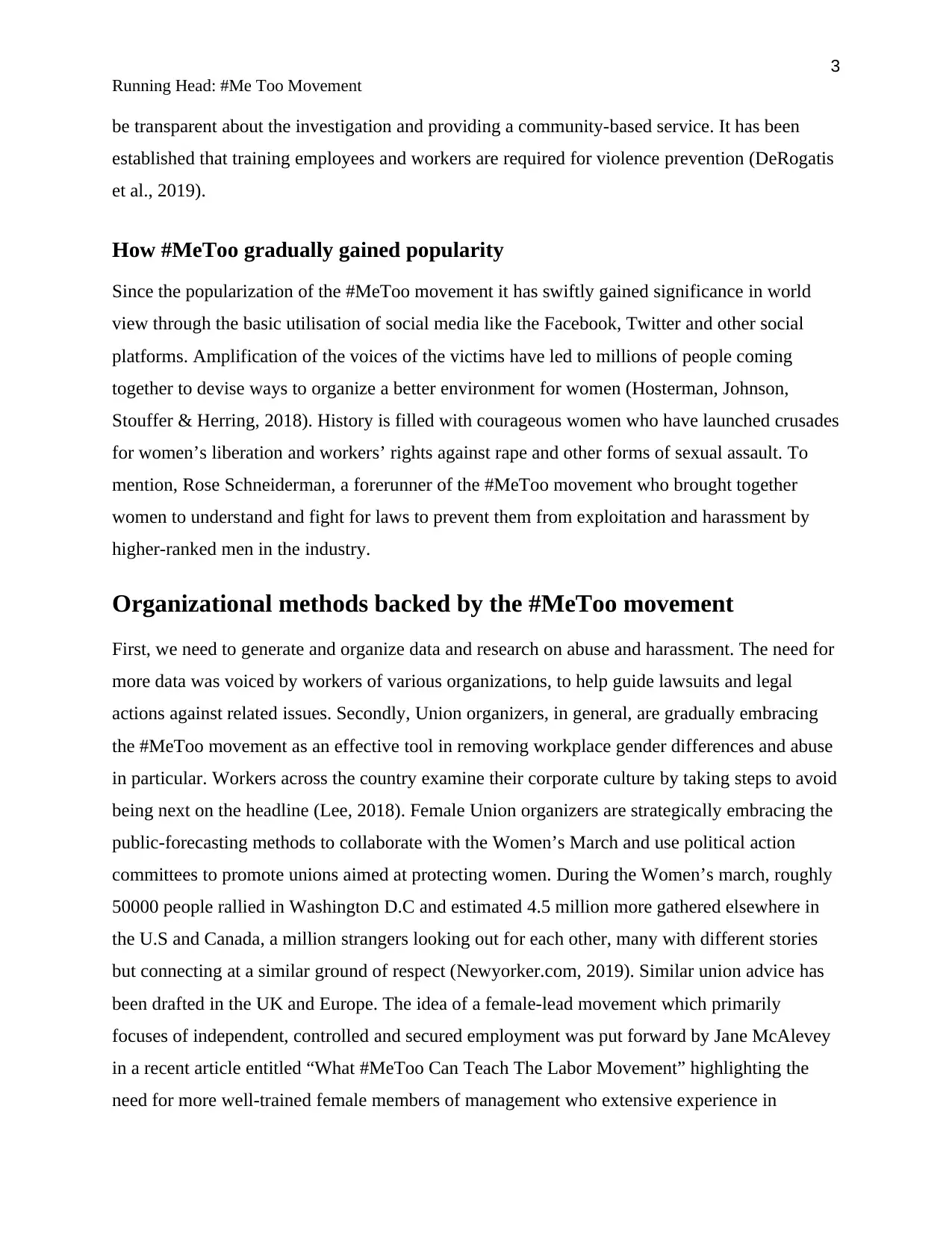
3
Running Head: #Me Too Movement
be transparent about the investigation and providing a community-based service. It has been
established that training employees and workers are required for violence prevention (DeRogatis
et al., 2019).
How #MeToo gradually gained popularity
Since the popularization of the #MeToo movement it has swiftly gained significance in world
view through the basic utilisation of social media like the Facebook, Twitter and other social
platforms. Amplification of the voices of the victims have led to millions of people coming
together to devise ways to organize a better environment for women (Hosterman, Johnson,
Stouffer & Herring, 2018). History is filled with courageous women who have launched crusades
for women’s liberation and workers’ rights against rape and other forms of sexual assault. To
mention, Rose Schneiderman, a forerunner of the #MeToo movement who brought together
women to understand and fight for laws to prevent them from exploitation and harassment by
higher-ranked men in the industry.
Organizational methods backed by the #MeToo movement
First, we need to generate and organize data and research on abuse and harassment. The need for
more data was voiced by workers of various organizations, to help guide lawsuits and legal
actions against related issues. Secondly, Union organizers, in general, are gradually embracing
the #MeToo movement as an effective tool in removing workplace gender differences and abuse
in particular. Workers across the country examine their corporate culture by taking steps to avoid
being next on the headline (Lee, 2018). Female Union organizers are strategically embracing the
public-forecasting methods to collaborate with the Women’s March and use political action
committees to promote unions aimed at protecting women. During the Women’s march, roughly
50000 people rallied in Washington D.C and estimated 4.5 million more gathered elsewhere in
the U.S and Canada, a million strangers looking out for each other, many with different stories
but connecting at a similar ground of respect (Newyorker.com, 2019). Similar union advice has
been drafted in the UK and Europe. The idea of a female-lead movement which primarily
focuses of independent, controlled and secured employment was put forward by Jane McAlevey
in a recent article entitled “What #MeToo Can Teach The Labor Movement” highlighting the
need for more well-trained female members of management who extensive experience in
Running Head: #Me Too Movement
be transparent about the investigation and providing a community-based service. It has been
established that training employees and workers are required for violence prevention (DeRogatis
et al., 2019).
How #MeToo gradually gained popularity
Since the popularization of the #MeToo movement it has swiftly gained significance in world
view through the basic utilisation of social media like the Facebook, Twitter and other social
platforms. Amplification of the voices of the victims have led to millions of people coming
together to devise ways to organize a better environment for women (Hosterman, Johnson,
Stouffer & Herring, 2018). History is filled with courageous women who have launched crusades
for women’s liberation and workers’ rights against rape and other forms of sexual assault. To
mention, Rose Schneiderman, a forerunner of the #MeToo movement who brought together
women to understand and fight for laws to prevent them from exploitation and harassment by
higher-ranked men in the industry.
Organizational methods backed by the #MeToo movement
First, we need to generate and organize data and research on abuse and harassment. The need for
more data was voiced by workers of various organizations, to help guide lawsuits and legal
actions against related issues. Secondly, Union organizers, in general, are gradually embracing
the #MeToo movement as an effective tool in removing workplace gender differences and abuse
in particular. Workers across the country examine their corporate culture by taking steps to avoid
being next on the headline (Lee, 2018). Female Union organizers are strategically embracing the
public-forecasting methods to collaborate with the Women’s March and use political action
committees to promote unions aimed at protecting women. During the Women’s march, roughly
50000 people rallied in Washington D.C and estimated 4.5 million more gathered elsewhere in
the U.S and Canada, a million strangers looking out for each other, many with different stories
but connecting at a similar ground of respect (Newyorker.com, 2019). Similar union advice has
been drafted in the UK and Europe. The idea of a female-lead movement which primarily
focuses of independent, controlled and secured employment was put forward by Jane McAlevey
in a recent article entitled “What #MeToo Can Teach The Labor Movement” highlighting the
need for more well-trained female members of management who extensive experience in
⊘ This is a preview!⊘
Do you want full access?
Subscribe today to unlock all pages.

Trusted by 1+ million students worldwide
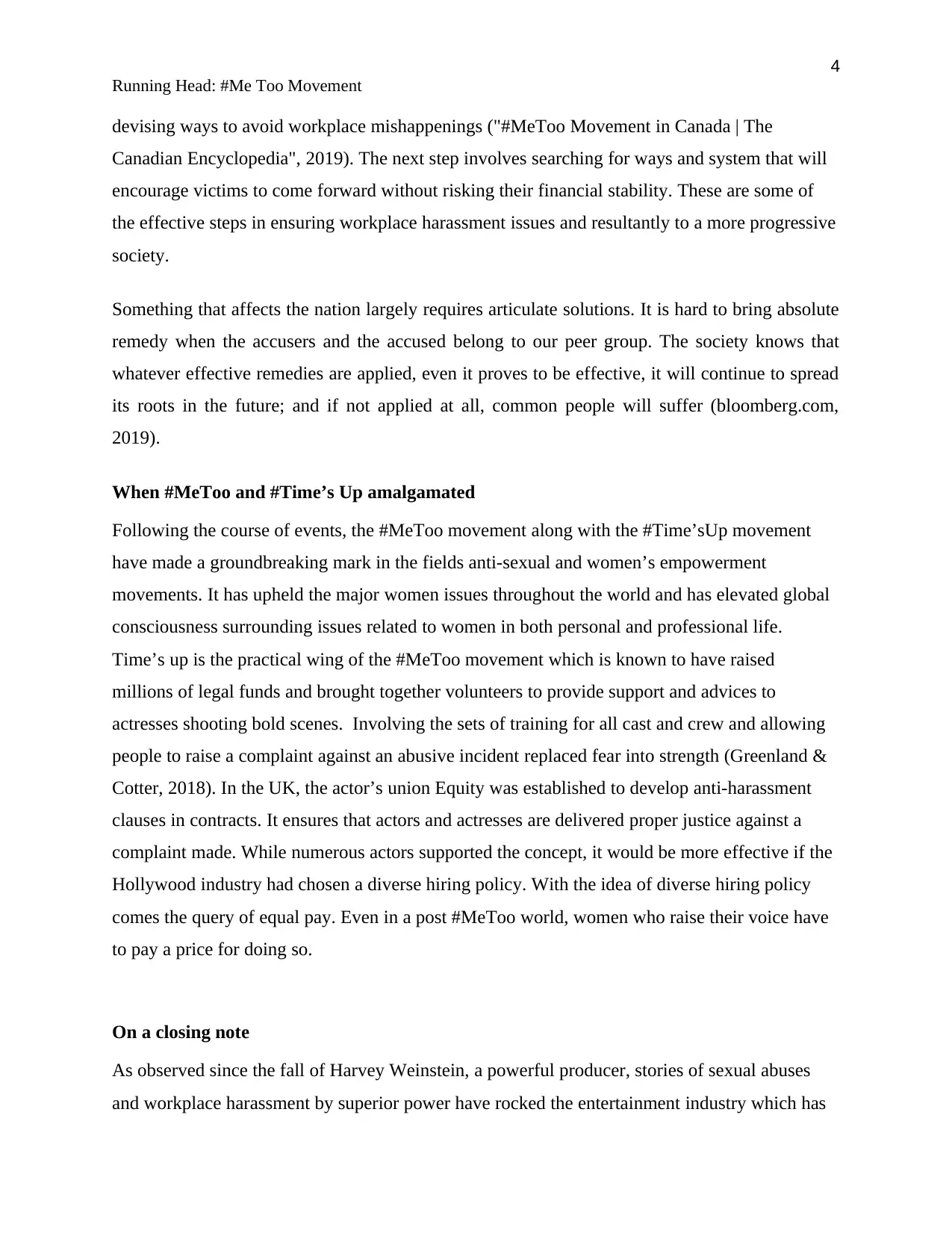
4
Running Head: #Me Too Movement
devising ways to avoid workplace mishappenings ("#MeToo Movement in Canada | The
Canadian Encyclopedia", 2019). The next step involves searching for ways and system that will
encourage victims to come forward without risking their financial stability. These are some of
the effective steps in ensuring workplace harassment issues and resultantly to a more progressive
society.
Something that affects the nation largely requires articulate solutions. It is hard to bring absolute
remedy when the accusers and the accused belong to our peer group. The society knows that
whatever effective remedies are applied, even it proves to be effective, it will continue to spread
its roots in the future; and if not applied at all, common people will suffer (bloomberg.com,
2019).
When #MeToo and #Time’s Up amalgamated
Following the course of events, the #MeToo movement along with the #Time’sUp movement
have made a groundbreaking mark in the fields anti-sexual and women’s empowerment
movements. It has upheld the major women issues throughout the world and has elevated global
consciousness surrounding issues related to women in both personal and professional life.
Time’s up is the practical wing of the #MeToo movement which is known to have raised
millions of legal funds and brought together volunteers to provide support and advices to
actresses shooting bold scenes. Involving the sets of training for all cast and crew and allowing
people to raise a complaint against an abusive incident replaced fear into strength (Greenland &
Cotter, 2018). In the UK, the actor’s union Equity was established to develop anti-harassment
clauses in contracts. It ensures that actors and actresses are delivered proper justice against a
complaint made. While numerous actors supported the concept, it would be more effective if the
Hollywood industry had chosen a diverse hiring policy. With the idea of diverse hiring policy
comes the query of equal pay. Even in a post #MeToo world, women who raise their voice have
to pay a price for doing so.
On a closing note
As observed since the fall of Harvey Weinstein, a powerful producer, stories of sexual abuses
and workplace harassment by superior power have rocked the entertainment industry which has
Running Head: #Me Too Movement
devising ways to avoid workplace mishappenings ("#MeToo Movement in Canada | The
Canadian Encyclopedia", 2019). The next step involves searching for ways and system that will
encourage victims to come forward without risking their financial stability. These are some of
the effective steps in ensuring workplace harassment issues and resultantly to a more progressive
society.
Something that affects the nation largely requires articulate solutions. It is hard to bring absolute
remedy when the accusers and the accused belong to our peer group. The society knows that
whatever effective remedies are applied, even it proves to be effective, it will continue to spread
its roots in the future; and if not applied at all, common people will suffer (bloomberg.com,
2019).
When #MeToo and #Time’s Up amalgamated
Following the course of events, the #MeToo movement along with the #Time’sUp movement
have made a groundbreaking mark in the fields anti-sexual and women’s empowerment
movements. It has upheld the major women issues throughout the world and has elevated global
consciousness surrounding issues related to women in both personal and professional life.
Time’s up is the practical wing of the #MeToo movement which is known to have raised
millions of legal funds and brought together volunteers to provide support and advices to
actresses shooting bold scenes. Involving the sets of training for all cast and crew and allowing
people to raise a complaint against an abusive incident replaced fear into strength (Greenland &
Cotter, 2018). In the UK, the actor’s union Equity was established to develop anti-harassment
clauses in contracts. It ensures that actors and actresses are delivered proper justice against a
complaint made. While numerous actors supported the concept, it would be more effective if the
Hollywood industry had chosen a diverse hiring policy. With the idea of diverse hiring policy
comes the query of equal pay. Even in a post #MeToo world, women who raise their voice have
to pay a price for doing so.
On a closing note
As observed since the fall of Harvey Weinstein, a powerful producer, stories of sexual abuses
and workplace harassment by superior power have rocked the entertainment industry which has
Paraphrase This Document
Need a fresh take? Get an instant paraphrase of this document with our AI Paraphraser
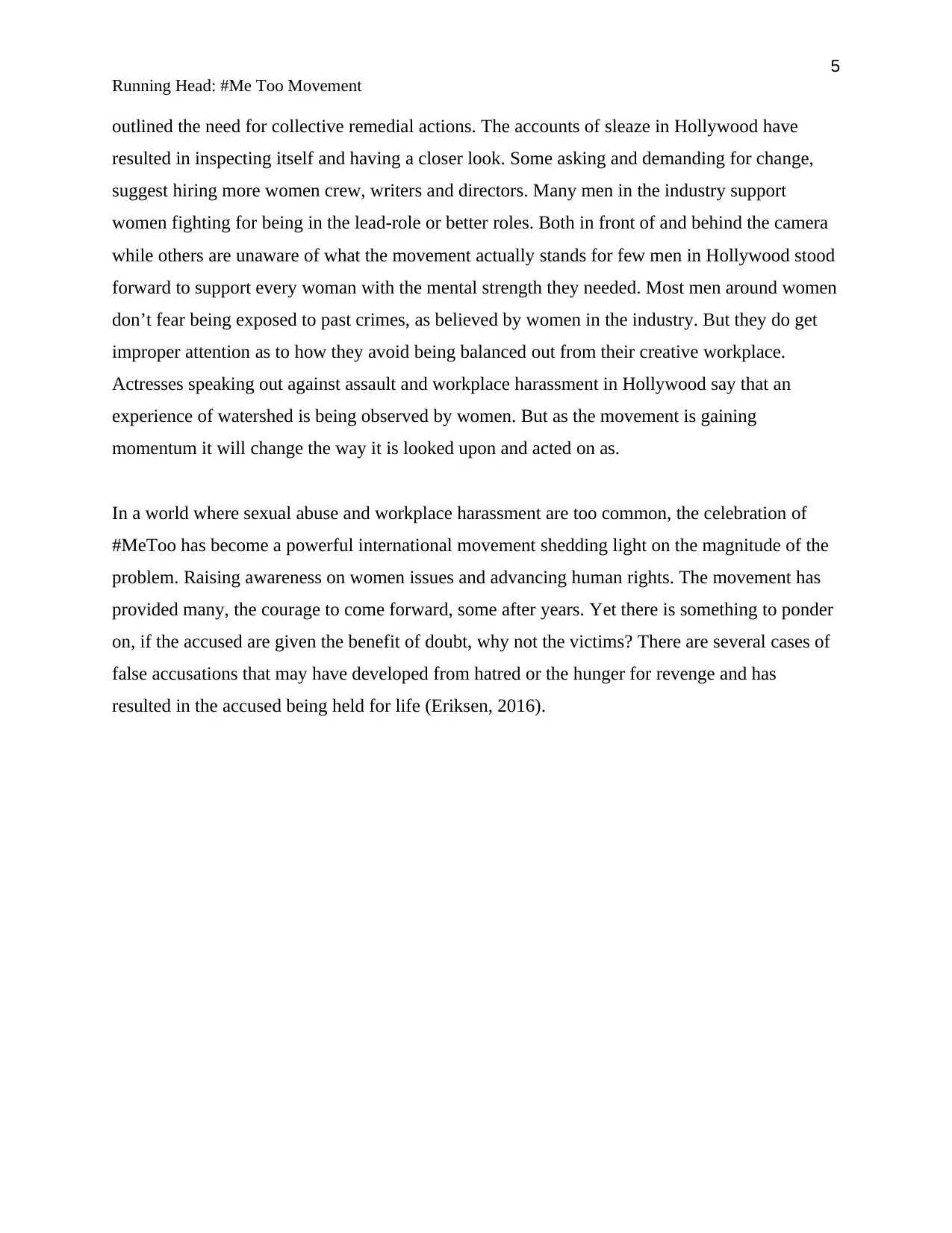
5
Running Head: #Me Too Movement
outlined the need for collective remedial actions. The accounts of sleaze in Hollywood have
resulted in inspecting itself and having a closer look. Some asking and demanding for change,
suggest hiring more women crew, writers and directors. Many men in the industry support
women fighting for being in the lead-role or better roles. Both in front of and behind the camera
while others are unaware of what the movement actually stands for few men in Hollywood stood
forward to support every woman with the mental strength they needed. Most men around women
don’t fear being exposed to past crimes, as believed by women in the industry. But they do get
improper attention as to how they avoid being balanced out from their creative workplace.
Actresses speaking out against assault and workplace harassment in Hollywood say that an
experience of watershed is being observed by women. But as the movement is gaining
momentum it will change the way it is looked upon and acted on as.
In a world where sexual abuse and workplace harassment are too common, the celebration of
#MeToo has become a powerful international movement shedding light on the magnitude of the
problem. Raising awareness on women issues and advancing human rights. The movement has
provided many, the courage to come forward, some after years. Yet there is something to ponder
on, if the accused are given the benefit of doubt, why not the victims? There are several cases of
false accusations that may have developed from hatred or the hunger for revenge and has
resulted in the accused being held for life (Eriksen, 2016).
Running Head: #Me Too Movement
outlined the need for collective remedial actions. The accounts of sleaze in Hollywood have
resulted in inspecting itself and having a closer look. Some asking and demanding for change,
suggest hiring more women crew, writers and directors. Many men in the industry support
women fighting for being in the lead-role or better roles. Both in front of and behind the camera
while others are unaware of what the movement actually stands for few men in Hollywood stood
forward to support every woman with the mental strength they needed. Most men around women
don’t fear being exposed to past crimes, as believed by women in the industry. But they do get
improper attention as to how they avoid being balanced out from their creative workplace.
Actresses speaking out against assault and workplace harassment in Hollywood say that an
experience of watershed is being observed by women. But as the movement is gaining
momentum it will change the way it is looked upon and acted on as.
In a world where sexual abuse and workplace harassment are too common, the celebration of
#MeToo has become a powerful international movement shedding light on the magnitude of the
problem. Raising awareness on women issues and advancing human rights. The movement has
provided many, the courage to come forward, some after years. Yet there is something to ponder
on, if the accused are given the benefit of doubt, why not the victims? There are several cases of
false accusations that may have developed from hatred or the hunger for revenge and has
resulted in the accused being held for life (Eriksen, 2016).
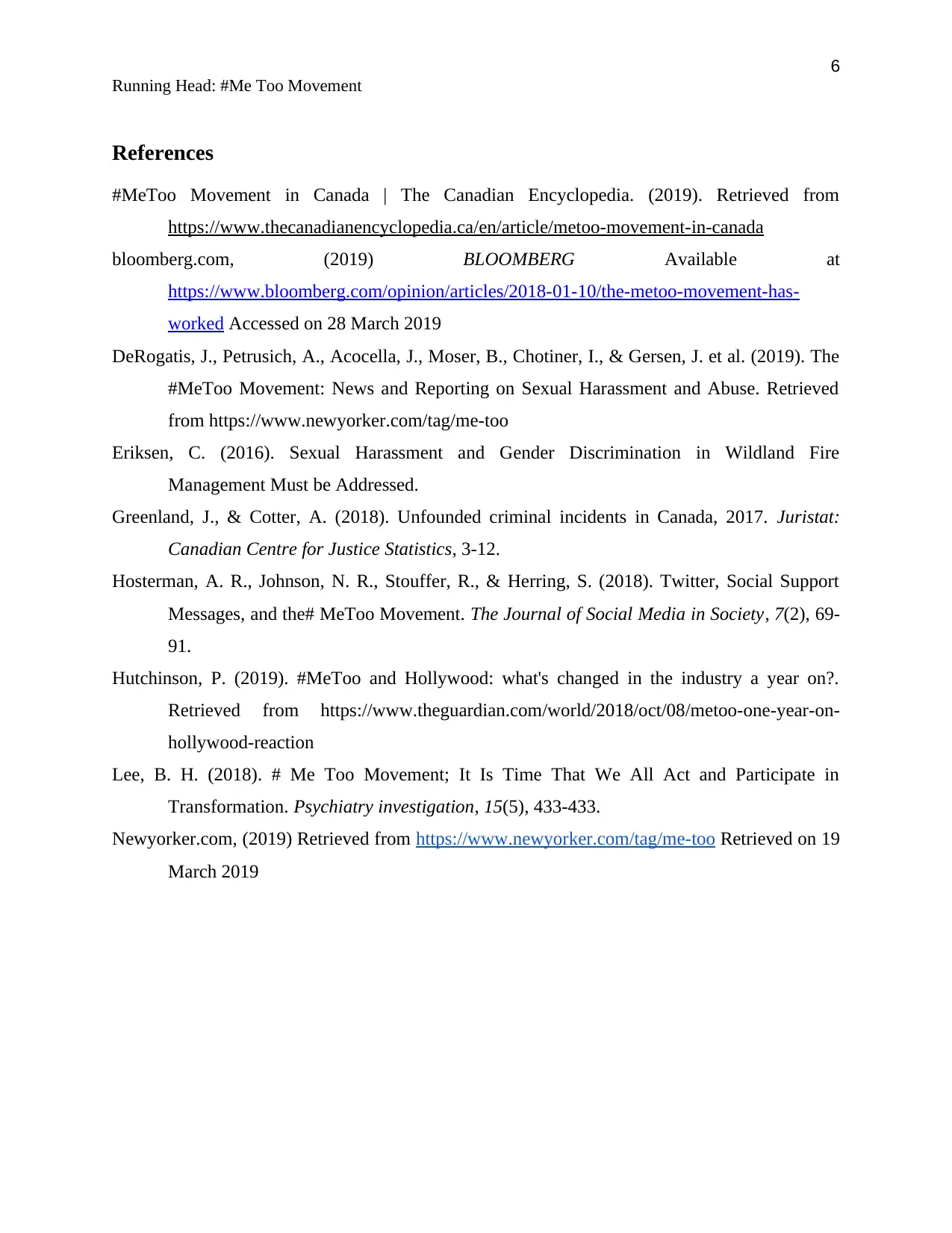
6
Running Head: #Me Too Movement
References
#MeToo Movement in Canada | The Canadian Encyclopedia. (2019). Retrieved from
https://www.thecanadianencyclopedia.ca/en/article/metoo-movement-in-canada
bloomberg.com, (2019) BLOOMBERG Available at
https://www.bloomberg.com/opinion/articles/2018-01-10/the-metoo-movement-has-
worked Accessed on 28 March 2019
DeRogatis, J., Petrusich, A., Acocella, J., Moser, B., Chotiner, I., & Gersen, J. et al. (2019). The
#MeToo Movement: News and Reporting on Sexual Harassment and Abuse. Retrieved
from https://www.newyorker.com/tag/me-too
Eriksen, C. (2016). Sexual Harassment and Gender Discrimination in Wildland Fire
Management Must be Addressed.
Greenland, J., & Cotter, A. (2018). Unfounded criminal incidents in Canada, 2017. Juristat:
Canadian Centre for Justice Statistics, 3-12.
Hosterman, A. R., Johnson, N. R., Stouffer, R., & Herring, S. (2018). Twitter, Social Support
Messages, and the# MeToo Movement. The Journal of Social Media in Society, 7(2), 69-
91.
Hutchinson, P. (2019). #MeToo and Hollywood: what's changed in the industry a year on?.
Retrieved from https://www.theguardian.com/world/2018/oct/08/metoo-one-year-on-
hollywood-reaction
Lee, B. H. (2018). # Me Too Movement; It Is Time That We All Act and Participate in
Transformation. Psychiatry investigation, 15(5), 433-433.
Newyorker.com, (2019) Retrieved from https://www.newyorker.com/tag/me-too Retrieved on 19
March 2019
Running Head: #Me Too Movement
References
#MeToo Movement in Canada | The Canadian Encyclopedia. (2019). Retrieved from
https://www.thecanadianencyclopedia.ca/en/article/metoo-movement-in-canada
bloomberg.com, (2019) BLOOMBERG Available at
https://www.bloomberg.com/opinion/articles/2018-01-10/the-metoo-movement-has-
worked Accessed on 28 March 2019
DeRogatis, J., Petrusich, A., Acocella, J., Moser, B., Chotiner, I., & Gersen, J. et al. (2019). The
#MeToo Movement: News and Reporting on Sexual Harassment and Abuse. Retrieved
from https://www.newyorker.com/tag/me-too
Eriksen, C. (2016). Sexual Harassment and Gender Discrimination in Wildland Fire
Management Must be Addressed.
Greenland, J., & Cotter, A. (2018). Unfounded criminal incidents in Canada, 2017. Juristat:
Canadian Centre for Justice Statistics, 3-12.
Hosterman, A. R., Johnson, N. R., Stouffer, R., & Herring, S. (2018). Twitter, Social Support
Messages, and the# MeToo Movement. The Journal of Social Media in Society, 7(2), 69-
91.
Hutchinson, P. (2019). #MeToo and Hollywood: what's changed in the industry a year on?.
Retrieved from https://www.theguardian.com/world/2018/oct/08/metoo-one-year-on-
hollywood-reaction
Lee, B. H. (2018). # Me Too Movement; It Is Time That We All Act and Participate in
Transformation. Psychiatry investigation, 15(5), 433-433.
Newyorker.com, (2019) Retrieved from https://www.newyorker.com/tag/me-too Retrieved on 19
March 2019
⊘ This is a preview!⊘
Do you want full access?
Subscribe today to unlock all pages.

Trusted by 1+ million students worldwide
1 out of 6
Related Documents
Your All-in-One AI-Powered Toolkit for Academic Success.
+13062052269
info@desklib.com
Available 24*7 on WhatsApp / Email
![[object Object]](/_next/static/media/star-bottom.7253800d.svg)
Unlock your academic potential
Copyright © 2020–2025 A2Z Services. All Rights Reserved. Developed and managed by ZUCOL.




